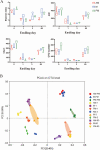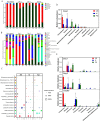Time of Day for Harvest Affects the Fermentation Parameters, Bacterial Community, and Metabolic Characteristics of Sorghum-Sudangrass Hybrid Silage
- PMID: 35862805
- PMCID: PMC9429962
- DOI: 10.1128/msphere.00168-22
Time of Day for Harvest Affects the Fermentation Parameters, Bacterial Community, and Metabolic Characteristics of Sorghum-Sudangrass Hybrid Silage
Abstract
To characterize the effects of time of day for harvest on the fermentation parameters, bacterial community, and metabolic characteristics of sorghum-sudangrass hybrid (SSG) silage, SSG (vegetative stage) harvested at 7:00 (AM), 12:00 (M), and 17:00 (PM) on three sunny days were ensiled for 1, 3, 7, 14, 30, and 60 days. Compared to AM silage, M and PM silages were characterized by delayed fermentation, unnormal lower final pH, and lower acetic acid production. In addition, PM silage contained higher residual water-soluble carbohydrates than other silages. After 60 days of ensiling, AM silage was dominated by Lactobacillus, whereas the bacterial communities of M and PM silages were complex and mainly composed of bacteria such as Delftia, Methylobacterium-Methylorubrum, Enhydrobacter, Acinetobacter, and Bacillus. The harvest time affected a wide range of metabolic pathways including "Metabolism" and "Cellular Processes" and "Organismal Systems" in SSG silage. Particularly, at the late stage of ensiling M silage exhibited highest relative abundances of amino acid metabolisms including "glycine, serine, and threonine metabolism," "phenylalanine metabolism," and lowest relative abundances of "lysine biosynthesis." These results suggest that the time of day for harvest could affect the fermentation parameters, bacterial community, and metabolic characteristics of SSG silage. Better SSG silage characteristics could be achieved through morning harvest. IMPORTANCE Ensiling is a common way for preserving green forages worldwide. Silage fermentation quality can vary greatly depending on the chemical and microbial characteristics of forage crop being ensiled. It is well documented that forages exhibit considerable variations in chemical composition and epiphytic microbiota during daylight. However, the effects of the time of day for harvest on silage fermentation is less investigated. Our results demonstrate that the time of day for harvest could affect the fermentation parameters, bacterial community, and metabolic characteristics of SSG hybrid silage. Harvesting SSG late in the day delayed fermentation process, lowered acetic acid production and final pH, and increased the residual water-soluble carbohydrates content in silage. Moreover, the delayed harvest time increased the relative abundances of bacteria such as Delftia, Methylobacterium-Methylorubrum, Acinetobacter, Enhydrobacter, and Bacillus, and amino acid metabolisms at the late stage of SSG ensiling. This study highlights the importance of diurnal changes in forage to fermentation characteristics, providing a strategy to improve silage quality through optimizing the harvest time.
Keywords: bacterial community; fermentation parameters; metabolic characteristics; sorghum-sudangrass hybrid; time of day for harvest.
Conflict of interest statement
The authors declare no conflict of interest.
Figures





Similar articles
-
Diurnal Variation of Epiphytic Microbiota: an Unignorable Factor Affecting the Anaerobic Fermentation Characteristics of Sorghum-Sudangrass Hybrid Silage.Microbiol Spectr. 2023 Feb 14;11(1):e0340422. doi: 10.1128/spectrum.03404-22. Epub 2022 Dec 15. Microbiol Spectr. 2023. PMID: 36519845 Free PMC article.
-
Abundance and diversity of epiphytic microbiota on forage crops and their fermentation characteristic during the ensiling of sterile sudan grass.World J Microbiol Biotechnol. 2021 Jan 12;37(2):27. doi: 10.1007/s11274-020-02991-3. World J Microbiol Biotechnol. 2021. PMID: 33433734
-
Gamma-ray irradiation and microbiota transplantation to separate the effects of chemical and microbial diurnal variations on the fermentation characteristics and bacterial community of Napier grass silage.J Sci Food Agric. 2022 Aug 15;102(10):4322-4332. doi: 10.1002/jsfa.11784. Epub 2022 Feb 4. J Sci Food Agric. 2022. PMID: 35044686
-
Silage review: Recent advances and future uses of silage additives.J Dairy Sci. 2018 May;101(5):3980-4000. doi: 10.3168/jds.2017-13839. J Dairy Sci. 2018. PMID: 29685273 Review.
-
Interaction between plants and epiphytic lactic acid bacteria that affect plant silage fermentation.Front Microbiol. 2023 Jun 6;14:1164904. doi: 10.3389/fmicb.2023.1164904. eCollection 2023. Front Microbiol. 2023. PMID: 37362945 Free PMC article. Review.
Cited by
-
The microbiota and metabolome dynamics and their interactions modulate solid-state fermentation process and enhance clean recycling of brewers' spent grain.Front Microbiol. 2024 Sep 12;15:1438878. doi: 10.3389/fmicb.2024.1438878. eCollection 2024. Front Microbiol. 2024. PMID: 39328918 Free PMC article.
-
Investigating the efficacy of an exopolysaccharide (EPS)-producing strain Lactiplantibacillus plantarum L75 on oat silage fermentation at different temperatures.Microb Biotechnol. 2024 Apr;17(4):e14454. doi: 10.1111/1751-7915.14454. Microb Biotechnol. 2024. PMID: 38568756 Free PMC article.
-
Exploring the aerobic stability, antioxidant and microbial community of Broussonetia papyrifera ensiled with ferulic acid esterase-producing Lactiplantibacillus plantarum in combination with cellulase and/or xylanase.BMC Microbiol. 2025 Aug 23;25(1):533. doi: 10.1186/s12866-025-04185-z. BMC Microbiol. 2025. PMID: 40847280 Free PMC article.
-
Evaluating the fermentation characteristics, bacterial community, and predicted functional profiles of native grass ensiled with different additives.Front Microbiol. 2022 Oct 18;13:1025536. doi: 10.3389/fmicb.2022.1025536. eCollection 2022. Front Microbiol. 2022. PMID: 36329844 Free PMC article.
-
Diurnal Variation of Epiphytic Microbiota: an Unignorable Factor Affecting the Anaerobic Fermentation Characteristics of Sorghum-Sudangrass Hybrid Silage.Microbiol Spectr. 2023 Feb 14;11(1):e0340422. doi: 10.1128/spectrum.03404-22. Epub 2022 Dec 15. Microbiol Spectr. 2023. PMID: 36519845 Free PMC article.
References
-
- McDonald P, Henderson AR, Heron SJE. 1991. The biochemistry of silage. Chalcombe Publications, Lincoln, UK.
-
- Gusmão JO, Lima LM, Ferraretto LF, Casagrande DR, Bernardes TF. 2021. Effects of hybrid and maturity on the conservation and nutritive value of snaplage. Anim Feed Sci Technol 274:114899. doi:10.1016/j.anifeedsci.2021.114899. - DOI
-
- Burns J, Fisher D, Mayland HF. 2007. Diurnal shifts in nutritive value of alfalfa harvested as hay and evaluated by animal intake and digestion. Crop Sci 47:2190–2197. doi:10.2135/cropsci2007.02.0072. - DOI
Publication types
MeSH terms
Substances
LinkOut - more resources
Full Text Sources
